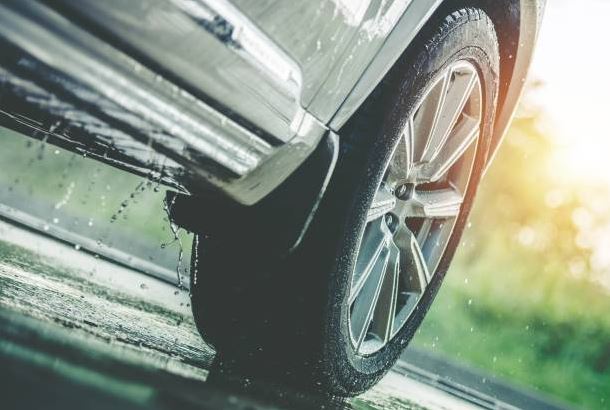Low-profile tires are characterized by thinner rubber, which allows the vehicle’svehicle’svehicle’s rims to stand out, improving overall aesthetics. But does this count as a disadvantage when driving in the rain?
A tire’s sidewall height does not directly determine its performance in the rain. As far as wet weather for driving goes, what matters is the tire’s tread pattern, whether for low-profile, regular, or high-profile tires.
Table of Contents
Low Profile Tires Performance In Rain
Despite this, low-profile tires will perform better than standard tires when driving in the rain, given that they are much wider and can generate better traction and grip on wet road surfaces. Again, it depends on the level of directional tread pattern the low-profile tire is designed with.
But when it comes to uneven road surfaces, low-profile tires are less effective (rain or no rain) because they’re rigid.
These fancy-looking tires are designed with shorter, stiffer, and shallower sidewalls than other tire types. As a result, the less rubber they contain, the better they can withstand all types of terrain, particularly wet surfaces.
The thinner rubber also adds an attractive touch since the large rims stand out more. In the rest of this post, we will walk through the nitty-gritty of low-profile tires, including their performance in other weather conditions, pros and cons, and how to get the best low-profile tire for your vehicle.
Low Profile Tire Performance in Snow
Low-profile tires have bad performance when used in snowy conditions. This is because their width spreads out the force instead of concentrating it at strategic points for breaking through the snow. This results in poor handling.
Low-profile tires are as bad as regular ones in the snow because they’re designed for something other than those conditions.
An ideal tire for snow will feature studs and chains to provide a stronger grip that will offer more traction.
Pros and Cons of Using Low-Profile Tires
Low-profile tires are popular with many drivers for good reasons. But despite the important advantages, there are also several tradeoffs with low-profile tires you should be aware of before shelling out cash to get one for your vehicle.
| Pros | Cons |
| The stiffer sidewalls and larger contact areas contribute to increased grip on smooth surfaces, enhanced wheel response, and improved handling. | Due to less space between your vehicle and the road, expect to absorb the shock of most road bumps, which results in a bumpier ride. |
| Low-profile tires take up less space, allowing for more stopping power due to the installation of larger braking hardware. | The thin nature of the tire makes it require little air, so in the event of a puncture, these tires will have rapid deflation. |
| The simple tread patterns and stiff sidewalls translate to increased fuel efficiency since the tires will have lower rolling resistance. | While simple tread patterns save fuel, they result in poorer traction on uneven surfaces. |
| Low-profile tires have a cool appearance, which explains why they grace sporty cars more. It all depends on the vehicle you drive. | Potholes that cause minor discomfort in regular tires can cause damage in low-profile tires due to fewer cushions between the wheels and rims. |
| high chances of bent rims punctured tires and even serious wheel issues. |
Are Low Profile Tires Easier To Damage?
Depending on the manufacturer, low-profile tires are durable, but the shorter width makes them more vulnerable to road damage than regular or high-profile tires.
On the plus side, the short side walls allow them to be responsive on curvy roads while maintaining a beautiful wheel appearance.
Which are better, low-profile or high-profile tires?
The choice between low-profile and high-profile tires comes down to your expectations of driving experience. No matter your option, you’d be trading one perk for another.
For example, low-profile tire drivers enjoy the appearance, responsiveness, and fuel economy. Some of which high-profile tires cannot provide to the same extent. On the other hand, low-profile tires have more friction, which causes a lot of noise.
Also, drivers who use low-profile tires have higher chances of bumpier rides, bent rims, and rapid deflation.
It would help if you also considered the manufacturer you buy from. The best manufacturers for low profiles are Pirelli, Michelin, Continental AG, Dunlop Tyres, and Goodyear.
Final Note
Many big players in the tire manufacturing business are now creating stronger and more comfortable sidewalls without necessarily increasing the sidewall heights for all types of cars and trucks.
The design trends for tires are moving towards a lower aspect ratio, stiffer sidewalls, and larger rims. So it is expected that people will question the performance of these low-profile tires when used in different terrains and weather conditions.
If you are considering a low-profile tire for your vehicle, its performance in the rain should not be the only factor to consider. It would help if you also considered your preferences: smooth ride, practical use, cool looks, and ultimately all-around performance.
Drivers with low-profile tires shoulder the responsibility of upgrading the suspension, installing larger rims and brakes, calculating correct sizes, and buying new tires often. If you are not ready for these, you’reyou’reyou’re better off staying high-profile.

